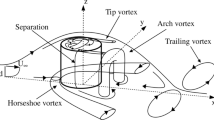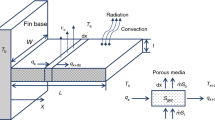Abstract
Design of an optimal extended surface having functionally graded material is significant in cooling performance of hot attached structures in technological applications. The present endeavor is to search for axially variable thermal conductivity formula for a prescribed longitudinal fin shape of rectangular or triangular cross section. Heat transfer is presumed to take place through conductive, convective and radiative effects. The well-known fact is that it is not possible to solve in closed-form the highly nonlinear heat transfer equation under such considerations in general, unless some effects are ignored. Temperature or spatial dependence of material properties of the fin make the problem even harder to treat without numerical simulations. To help designer to avoid such simulations, prescribed temperature distributions in the form of elementary polynomial functions involving some shape parameters are utilized. Under operative geometric and thermal parameters such as the Biot number and the radiation parameter, exact solution formulae for the pertinent thermal conductivity distribution along the functionally graded extended surface are then obtained. The price to pay is only to work out the domain of definition of physical parameters acting on the loaded temperature profile.Designer can benefit from the advantage of the presented elementary solutions while analyzing the efficiency of convecting-radiating longitudinal fins of rectangular, triangular or a more general tapered longitudinal fin class cross sections and control/adjust the physical parameters to the desired temperature/material conditions. With a preloaded temperature profile to the energy equation, the tip temperature can be adjusted so as to enhance the heat transfer rate by increasing/decreasing the governing fin parameters. Such promising inverse problem of extracting axial thermal conductivity distribution from a prescribed temperature solution can also be utilized in other kinds of fin profiles without resorting to the numerical simulations.














Similar content being viewed by others
References
Deepa, D.; Thanigaivelan, R.; Venkateshwaran, M.: Identifying a suitable micro-fin material for natural convective heat transfer using multi-criteria decision analysis methods. Mater. Today: Proc. Mater. Today: Proc. 45, 1655–1659 (2021)
Huang, C.-H.; Tung, P.-W.: Numerical and experimental studies on an optimum Fin design problem to determine the deformed wavy-shaped heat sinks. Int. J. Thermal Sci. 151, 106282 (2020)
Abraham, J.D.; Dhoble, A.S.; Mangrulkar, C.K.: Numerical analysis for thermo-hydraulic performance of staggered cross flow tube bank with longitudinal tapered fins. Int. Commun. Heat Mass Transf. 118, 104905 (2020)
Huang, C.-H.; Wang, G.-J.: A design problem to estimate the optimal fin shape of LED lighting heat sinks. Int. J. Heat Mass Transf. 106, 1205–1217 (2017)
Huang, C.-H.; Chung, Y.-L.: An inverse problem in determining the optimum shapes for partially wet annular fins based on efficiency maximization. Int. J. Heat Mass Transf. 90, 364–375 (2015)
Hajmohammadi, M.R.; Rasouli, E.; Elmi, M.A.: Geometric optimization of a highly conductive insert intruding an annular fin. Int. J. Heat Mass Transf. 146, 118910 (2020)
Sarani, I.; Payan, S.; Payan, A.; Nada, S.A.: Enhancement of energy storage capability in RT82 phase change material using strips fins and metal-oxide based nanoparticles. J. Energy Storage 32, 102009 (2020)
Oclon, P.; Łopata, S.; Stelmach, T.; Li, M.; Zhang, J.-F.; Mzad, H.; Tao, W.-Q.: Design optimization of a high-temperature fin-and-tube heat exchanger manifold-A case study. Energy 215, 119059 (2021)
Mochizuki, H.: Modeling of an air cooler with finned heat transfer tube banks using the RELAP5-3D code. Nucl. Eng. Des. 370, 110902 (2020)
Kraus, A.D.; Aziz, A.; Welty, J.: Extended surface heat transfer. Wiley, New York (2001)
Lienhard, J.H.; Lienhard, J.H.: A heat transfer textbook, 3rd edn Phlogiston Press, Cambridge (2011)
Mt Aznam, S.; Artisham, N.; Ghani, C.; Chowdhury, M.S.H.: A numerical solution for nonlinear heat transfer of fin problems using the Haar wavelet quasilinearization method. Results Phys. 14, 102393 (2019)
Aderogba, A.A.; Fabelurin, O.O.; Akindeinde, S.O.; Adewumi, A.O.; Ogundare, B.S.: Nonstandard finite difference approximation for a generalized Fins problem. Math. Computers Simul. 178, 183–191 (2020)
Zhang, C.-N.; Li, X.-F.: Temperature distribution of conductive-convective-radiative fins with temperature-dependent thermal conductivity. Int. Commun. Heat Mass Transfer 117, 104799 (2020)
Bochicchio, I.; Naso, M.G.; Vuk, E.; Zullo, F.: Convecting-radiating fins: explicit solutions, efficiency and optimization. Appl. Math. Modell. 89, 171–187 (2021)
Hatami, M.; Ganji, D.D.: Investigation of refrigeration efficiency for fully wet circular porous fins with variable sections by combined heat and mass transfer analysis. Int. J. Refrigeration 40, 149–154 (2014)
Singla, R.K.; Das, R.: Application of decomposition method and inverse prediction of parameters in a moving fin. Energy Conv. Manage. 84, 268–281 (2014)
Turkyilmazoglu, M.: Efficiency of heat and mass transfer in fully wet porous fins: Exponential fins versus straight fins. Int. J. Refrigeration 46, 158–164 (2014)
Kundu, B.; Lee, K.S.: Exact analysis for minimum shape of porous fins under convection and radiation heat exchange with surrounding. Int. J. Heat Mass Transfer 81, 439–448 (2015)
Mueller, D.W., Jr.; Abu-Mulaweh, H.I.: Prediction of the temperature in a fin cooled by natural convection and radiation. Appl. Therm. Eng. 26(14–15), 1662–1668 (2006)
Dulkin, I.N.; Garasko, G.I.: Analysis of the 1-D heat conduction problem for a single fin with temperature dependent heat transfer coefficient: Part I -Extended inverse and direct solutions. Int. J. Heat Mass Transfer 51, 3309–3324 (2008)
Khani, F.; Ahmadzadeh, M.; Raji, H.; Nejad, H.: Analytical solutions and efficiency of the nonlinear fin problem with temperature-dependent thermal conductivity and heat transfer coefficient. Commun Nonlinear Sci. Numer. Simul. 14, 3327–3338 (2009)
Moitsheki, R.J.; Hayat, T.; Malik, M.Y.: Some exact solutions of the fin problem with a power law temperature-dependent thermal conductivity. Nonlinear Anal.: Real World Appl. 11, 3287–3294 (2010)
Kader, A.H.A.; Latif, M.S.A.; Nour, H.M.: General exact solution of the fin problem with variable thermal conductivity. Propul. Power Res. 5, 63–69 (2016)
Huang, Y.; Li, X.-F.: Exact and approximate solutions of convective-radiative fins with temperature-dependent thermal conductivity using integral equation method. Int. J. Heat Mass Transfer 150, 119303 (2020)
Kumar, S.; Kumar, S.D.: A numerical study of new fractional model for convective straight fin using fractional-order Legendre functions. Chaos, Solitons and Fractals 141, 110282 (2020)
Turkyilmazoglu, M.: A direct solution of temperature field and physical quantities for the nonlinear porous fin problem. Int. J. Numer. Methods Heat Fluid Flow 27, 516–529 (2017)
Imani, G.: Three dimensional lattice Boltzmann simulation of steady and transient finned natural convection problems with evaluation of different forcing and conjugate heat transfer schemes. Computers Math. Appl. 74, 1362–1378 (2017)
Mostafavi, A.; Parhizi, M.; Jain, A.: Semi-analytical thermal modeling of transverse and longitudinal fins in a cylindrical phase change energy storage system. Int. J. Thermal Sci. 153, 106352 (2020)
Cao, Z.; Zhou, J.; Wei, J.; Sun, D.: Bo Yu, Direct numerical simulation of bubble dynamics and heat transfer during nucleate boiling on the micro-pin-finned surfaces. Int. J. Heat Mass Transfer 163, 120504 (2020)
Shahabadi, M.; Mehryan, S.A.M.; Ghalambaz, M.; Ismael, M.: Controlling the natural convection of a non-Newtonian fluid using a flexible fin. Appl. Math. Modell. (2020). https://doi.org/10.1016/j.apm.2020.11.02
Rezaee, M.; Taheri, A.A.; Jafari, M.: Experimental study of natural heat transfer enhancement in a rectangular finned surface by EHD method. Int. J. Heat Mass Transfer 119, 104969 (2020)
Keramat, F.; Azari, Ahmad; Rahideha, H.; Abbasi, Mohsen: A CFD parametric analysis of natural convection in an H-shaped cavity with two-sided inclined porous fins. J. Taiwan Instit. Chem. Eng. 114, 142–152 (2020)
Peng, B.; He, Z.; Wang, H.; Su, F.: Optimization of patterned-fins for enhancing charging performances of phase change materials-based thermal energy storage systems. Int. J. Heat Mass Transfer 164, 120573 (2021)
Liang, C.; Rao, Y.: Numerical study of turbulent flow and heat transfer in channels with detached pin fin arrays under stationary and rotating conditions. Int. J. Thermal Sci. 160, 106659 (2021)
Al-Khafaji, O.R.; Alabbas, A.H.: Computational fluid dynamics modeling study for the thermal performance of the pin fins under different parameters. IOP Conf. Ser.: Mater. Sci. Eng. 745, 012070 (2020)
Author information
Authors and Affiliations
Corresponding author
Rights and permissions
About this article
Cite this article
Turkyilmazoglu, M. Prescribed Temperature Profiles of Longitudinal Convective-Radiative Fins Subject to Axially Distributed Thermal Conductivities. Arab J Sci Eng 47, 15689–15703 (2022). https://doi.org/10.1007/s13369-022-06710-y
Received:
Accepted:
Published:
Issue Date:
DOI: https://doi.org/10.1007/s13369-022-06710-y




